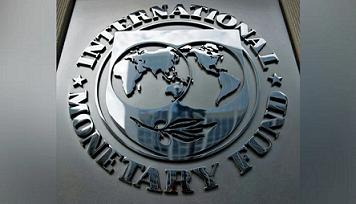-$20.11 billion at the end of June should be preserved
- IMF approved a loan of 4.7 billion dollars in Janu 30
-3rd installment be released next May if targets, conditions fulfilled
Under the International Monetary Fund (IMF) loan program, there are several criteria, targets and benchmarks for Bangladesh to meet as well as reform conditions. One of the most important criteria is the Net Foreign Reserve (NIR). Bangladesh's position in this index is quite fragile. Targeted reserve conservation has not been possible so far. Even according to the organization's revised target, Bangladesh is going to fail to fulfill this condition even in the March quarter of this year. Analysts said the country's reserves are not increasing due to lack of effective reforms in interest rate and foreign exchange market management.
According to the IMF loan program, there are conditions for meeting Quantitative Performance Criteria (QPC), Indicative Targets (IT) and Structural Benchmarks (SB). This includes NIR QPC. The IMF had set a target of 22.95 billion dollars in reserves in the March quarter last year. Bangladesh is able to preserve net reserves of 19.56 billion dollars though. In the next quarter i.e. at the end of June last year, net reserves were 19.56 billion dollars against the target of 23.74 billion dollars.
Meanwhile, the IMF board approved the second installment of the loan to Bangladesh in December last year. At that time, Bangladesh sought a concession for not meeting the NIR targets, which the organization also approved. The net reserve target is then revised downwards. According to that, the target of reserve conservation at the end of September last year stood at 17.99 billion, which was 25.32 billion dollars earlier. Similarly, at the end of December last year, there was a condition of reserve preservation of 26.81 billion dollars, but it was reduced to 17.78 billion dollars in the revised target. Despite that, Bangladesh failed to achieve the target in these two quarters.
According to the IMF's target, net reserves of $19.27 billion at the end of March and $20.11 billion at the end of June should be preserved. According to the data of Bangladesh Bank, according to the IMF's Balance of Payments and Investment Position Manual (BPM6) system, the gross foreign reserve (GIR) of the country at the end of March 27 was 19.45 billion dollars. The BPM6 method requires deducting reserve-related liabilities from GIR in determining net reserves as per IMF calculations. These include SDR allocations from the IMF and outstanding liabilities of Bangladesh with a maturity of less than one year and other foreign currency liabilities, non-resident liabilities in convertible currency, AKU, Japan Debt Relief Grant (JDRG) and foreign exchange clearing liabilities. Liability related to forward contracts, foreign currency swaps and other futures market contracts will also be excluded. Generally, there is a gap of 4-5 billion dollars between gross reserves and net reserves of Bangladesh. For example, there was a gap of 4 billion between GIR and NIR of Bangladesh at the end of June last year and 4.4 billion dollars at the end of October last year.
Dr. Zahid Hossain, the former chief economist of World Bank's Dhaka office said since September last year, the flow of remittances has increased in the country.
But we have not made any kind of reform in foreign exchange management. We are yet to come out of the Buffer-ABB model of dollar pricing. Moreover, dollars are not available at this rate. You have to pay more than that. The official rate of dollar is Tk110, very little is being traded at this rate. It is only valid for buying dollars from Bangladesh Bank and for inter-bank transactions. On the other hand, an informal dollar market has developed outside the carb market. It provides exclusive business opportunities for those who have agents abroad and are in good hands. The opportunity that everyone will trade dollars together is quite limited. As a result, the amount of dollars that would have come here if it was a truly competitive market is not coming here.
In order to achieve the IMF's reserve target, Bangladesh Bank should stop selling dollars and buy them from the market. Zahid Hossain said if not, how will the reserve increase? Again, if the dollar is taken through swap, it will be excluded from the net reserve according to the IMF. Out of the swap, however, Bangladesh Bank bought some dollars, though more than it sold.
The economist said the problem is over, there is no discomfort in the foreign exchange market - this is not a correct description in terms of reality. There is no doubt that there is some improvement, meaning that the discomfort is somewhat reduced. However, it did not go to the extent that Bangladesh Bank no longer had to sell dollars. Moreover, remittances have not increased to such an extent that banks have enough dollars. They are not looking to buy dollars from the central bank, but are interested in selling them.
When asked about the current net reserve of Bangladesh, the former economist of the World Bank said “according to the BPM6 method of the IMF, the amount of gross reserve that we have after deducting the short-term liability is the net reserve.” In this case the short term liability is between 4-5 billion dollars. Accordingly, I estimate that our net reserves will not be more than 16 billion dollars at the moment.
Dr. Ahsan H Mansoor, Former IMF economist and executive director of Policy Research Institute of Bangladesh (PRI) said interest is at the root of everything. This should increase the value of money. Then the trend of converting dollars into taka will increase. At present the remittance flow has increased slightly. But it remains to be seen if it is genuine remittance, or money that was smuggled out of the country is entering the country as legitimate money in the form of remittance.
IMF Executive Board meeting on January 30 last year approved a loan proposal of 4.7 billion dollars for Bangladesh. Bangladesh will get this loan in 42 months in seven installments. The average loan interest rate is 2.2 percent. There are two types of loans out of the $4.7 billion. 3.3 billion dollars will be available from Extended Credit Facility or Extended Fund (ECF & EFF). 1.4 billion dollars will be available under the Resilience and Sustainability Facility (RSF). During the loan program till 2026, Bangladesh will have to implement various conditions and reform programs. Bangladesh received 476 million dollars of the first installment of the loan from the IMF in February last year. In December of that year, the second installment of the loan was $689.8 million. However, the third installment of money is expected to be released next May after meeting the targets and conditions and evaluating the implementation of reforms until last December. For this reason, a review mission of the IMF will come to Bangladesh at the end of next April.
ZH






